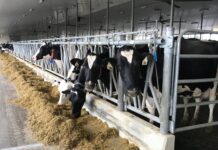[Theme music fades up, sounds of farm animals, tractors, computer clicks and digital noise]
Hannah Senior: Agriculture is one of humanity’s crowning achievements; the ability to feed ourselves via a network of global, national and local food systems. Agriculture is a foundational block critical to our success as a civilization. But at this point in our shared history, that very foundational block is now starting to fail. Economic imbalances, labor shortages, and the huge environmental impacts of agriculture has led us down a path that is totally unsustainable. Something has to change. And introducing new technology to agriculture might just help us steer away from the bleak future we’re likely all staring at.
So far in this podcast series, we’ve explored the complex issues facing the food system, including labor shortages, poor farmer profitability, and the huge environmental toll modern agriculture takes on the planet. We’ve asked why agriculture needs entrepreneurs to help drive change, and explored how to best support emerging AgTech solutions. We’ve also spoken to farmers about how they can better engage with entrepreneurs, and the barriers to adoption that they face. And we learned more about business accelerators, and farmer-led support for innovative new companies.
In the last episode, we heard from three entrepreneurs about their experiences starting a company in the world of agriculture, with all the opportunities and challenges that come with it. While researching this podcast, a recurring theme that came up in so many of my conversations was access to finance for starting businesses. As with most startups, money is the one thing they need and can be super hard to find.
So in this episode, I’m going to be talking about models of financing entrepreneurial ventures. I didn’t set out to explore investment models. And you might think that this has nothing to do with how we make agriculture more productive, profitable, and sustainable. But as I researched this topic, it rapidly became clear to me that what drives behaviors and incentives all the way through the chain of an entrepreneurial ecosystem is the model of investment used.
I’ll be looking at the model that’s most prominent in the contemporary startup world, as well as emerging and alternative models that may offer better solutions, in particular for AgTech startups. I’ll also be asking whether some new ideas around financing startups might be really helpful in creating a better ecosystem for entrepreneurs tackling the issues facing modern agriculture.
[Music fades in and out. Tractor sounds]
Hannah Senior: I’m going to start off by looking at the classic venture capital or VC finance model. Two of the three entrepreneurs I spoke to in Episode 4 have venture capital backers and this type of investment is really dominant in the landscape of entrepreneurship and startups. Not all businesses need ongoing tranches of investment, some become self-funding and grow with their own resources. Focusing on achieving profitability is usually a much stronger foundation than a high stakes model of “Blitzscaling”. The growth and pursuit of market share, often without profitability, or a sound financial model, and sometimes even without revenue.
However, whichever route the need for some kind of investment to develop a product and team, create kit and inventory, and move quickly before copycats can emerge is a challenge that most businesses face. And in the UK in 2019, the most recent year for which I have data, at least 58% of investment raised by AgTech companies came from VC firms or corporate VCs. During my time at Stanford, which is at the epicenter of Silicon Valley and the Silicon Valley model of entrepreneurship that we discussed in episode 2. I learned a lot about VC. Indeed, many of my MBA classmates have gone on to found or run VC funds or be backed by them. So the natural place to start given its prevalence is to get a better understanding of what exactly venture capital is.
In Episode 2 of this podcast, we talked about the impact that Silicon Valley has on our mental model of entrepreneurship. The classic story of investment in that model goes something like this: a new business is initially financially supported by the entrepreneurs themselves, and then money from the three F’s: friends, family and fools. It’s important to note that all investing in a
new business is risky, and the earlier in its lifecycle, the riskier it is. So these are the bravest, most trusting or the most Foolish investors of all. After this, as the company needs more capital, an angel investor or two might step in, typically a high net worth person with deep pockets, who’s willing to invest a larger sum of money – usually in return for a share of the business. Assuming all goes well, and the company continues to grow, even larger sums of money are then needed. The founders turned to professional investors, people who are paid to find promising startups to invest in using capital that comes from endowments, wealthy families, maybe even pension funds, etc. These are venture capitalists.
The job of these professional investors is to ensure that their investments generate a good return for the ultimate owners of the capital who entrusted them the money to invest. The venture capital model we see today is as much part of the Silicon Valley story as the microprocessor. VCs are not looking for any old company to invest in, they have very specific needs in order to make their business model work. We’ll dig into these in more detail. But in summary, some of the top priorities for an attractive VC investment are: 1) A company that could grow to be really large and really valuable. 2) That it can do this relatively quickly. 3) A company that can be sold or launched on the public stock market. And 4) All of this has to happen in about a 10 year timeframe – and without too much by way of capital requirements. These requirements and their fit with AgTech is something we’ll explore in more detail. But before I do that, bear with me while I do a little refresh on some key principles in finance, which will help in this conversation.
One is that when it comes to investing, the greater the risk, the greater the reward that is expected. Startup investing is risky. And so the expectation is that the returns from investing in venture capital will be greater than those that could be made through other less risky routes like say investing in the stock market. Another is the difference between equity and debt. Typically, the VC fund or funds take equity, a share of ownership of the company in exchange for the investment. This is because if the company is successful, it allows an almost unlimited upside of the company and hence the investors share of it could grow to be worth almost any amount of money. If the company is not successful, however, the investor may lose all their
money. This is quite different from debt such as a loan. Debt is less risky, but has less scope for making outsize gains, because the repayment terms on that debt define how much return will be given.
Okay, so back to venture capitalism. I mentioned that the opportunity to grow into a giant highly valuable company is important. One of the reasons for this is an expectation baked into this method that most of the ventures they back will fail. Rasmus Hartmann, an associate professor at the Copenhagen Business School, who we’ve heard from in previous episodes, explained it like this.
Rasmus Hartmann: It’s very, very hard for even very skilled venture capitalists to pick winners. And I mean, here we’re talking about people whose job it is and whose expertise should be identifying companies that have the potential to become very valuable. That’s what they do. That’s why they get funding from other sources so that they can invest. So what venture capitalists will often do, especially in the tech sector, is to build a portfolio and hope that some of these companies succeed, and hope that the ones who succeed really succeed wildly, right, so everyone’s hoping to have the new Google the new Facebook, and then to have a portfolio that’s big enough to capture those outliers because it’s really the outliers that drive your returns.
Hannah Senior: Correlation Ventures, a data driven VC fund, published a report in 2019, which estimated that 64% of all VC backed companies return a loss. This means to offset these losses and make the financial return the investors want, the remaining wins have to be big, which is why the term “Unicorn” has entered our business vocabulary. It’s a term for those very rare young companies that grow to a big win: a value of $1 billion or more. It’s the holy grail of VC investment. To give you an idea of how rare this kind of unicorn company is, to quote VC firm partner Mike Maples 10 companies out of 10,000 every year create 95% of all the value in the startup business. Or using some UK based stats: there have been 16 venture backed companies in the UK that have achieved Unicorn status in the last 10 years. That’s a miniscule 0.20% of all UK based VC backed companies. Or put another way, it’s just 0.0002% of all the companies founded in the UK in a 10 year period. It’s really, really tiny.
Some AgTech companies absolutely fit this template of being able to grow very big, very fast with relatively little investment. A poster child for this is Climate Corp, an agriculture and weather data Company, which was sold to Monsanto for almost a billion dollars in 2013. But many, many companies do not fit so well. Peter Herz is the founder of the VC fund 1st Course Capital, which he runs alongside the not for profit business accelerator Food System 6 that we looked at in Episode 2.
Peter Herz: In reality, venture capital only serves a vanishingly small percentage of all the startups and all of the innovation that happens. It’s vanishingly small. Admittedly, though, you know, the very biggest outcomes and therefore the most visible, tend to be these venture capital backed entities. And understanding where your innovation fits will save you a lot of time because if you are building something that really isn’t venture capital financeable, then you know, you can avoid going through that whole process, and structure what you’re building in a way that will appeal to capital sources that will fund it.
Hannah Senior: One reason that VC is not a good fit for lots of AgTech companies, is that the diversity and complexity of agriculture makes it harder for one product or service to be a good fit for a huge market, in the way that software for personal computers or mobile phones could be. It’s also because much of the work in agriculture is not in data or computing, it’s in physical stuff. And that often means a need for capital hungry inventory, or infrastructure. It’s a lot easier to roll out a digital solution that exists on a computer than a physical solution that needs to be shipped out to clients, installed and connected, and staff trained to use it. So Peter believes it’s important that entrepreneurs don’t just look to VCs as the only form of funding – because so few companies fit the VC criteria
Peter Herz: We talk to somewhere around three or four dozen companies we pass on for every one we invest in, and many of them are innovations that may well be interesting. And we help them, guiding them to sources of capital that are more aligned with what they are trying to build. For example, there are many innovations that require infrastructure. And it turns out one of the better ways rather than venture capital, if you need expensive infrastructure to do an
innovation, you can actually build out a mix of capital sources, where the equipment, the infrastructure, the plant, whatever it is, can be financed with debt that’s secured by the plant itself. And then the risk equity that you need to raise is much smaller. And you can get that from many different sources.
Hannah Senior: Sarah Nolet is a food systems innovation expert, the CEO and founder of AgThentic, a global food and agriculture strategy firm, and co-founder of Tenacious Ventures, Australia’s first dedicated agrifood tech VC firm. She also recognizes that not all businesses are a fit for VC funding.
Sarah Nolet: We see a lot of businesses that look amazing, like we just know, they’re going to do really well. It’s a great business, it’s a great team, it’s a great area, they’ve got customers, but it’s not a fit for venture capital. So we look for, as you said, a certain timeline for returns like our fund is 10 years with two one year extensions. Traditionally, people in venture are looking for a roughly five to seven year kind of exit timeframe. And so the timeline might be one and returns profile might be one. If that business is doing well, they’ve got customers but based on the size of the market or the speed, you know, maybe they get bought for 3x, 5x or 8x. And ventures looking for 10x plus returns, you know, 20, 30,100x, is what people talk about. And so it might be a really good business but just might not be a fit for venture.
Hannah Senior: So if we’ve explored questions of scale and capital requirements, let’s also look at the questions of timeframe and the potential for exits which Sarah mentioned. Many AgTech companies take a long time to build. The entrepreneurs we spoke to in Episode 3 describe similar timelines, years of development before achieving any significant sales, and then acquiring customers through a slow, steady process. All were more than five years old, and were only just starting to scale up acquiring customers. And yet, as you heard from Sarah, most VC funds have promised their investors their money back in a fixed period of time, usually 10 years or so.
There is a lot of talk of patient capital, and some of the most famous VC firms, like Sequoia recently announced, are moving away from a fixed timeframe. But even so, in any investment,
the longer the capitalist is tied up, the greater the return expected at the end. So a related question is about exits. I mentioned that VC investors get equity, a share of the company, in exchange for their investment. The problem with this is that it’s not very liquid. It’s normally only turned into cold hard cash when someone else buys that equity off you. And this is why the focus on an exit is so important.
VC firms prefer to back companies that can exit by being acquired by another company, or by ‘going public’ – that is floating on the stock exchange. One of the concerns many in the AgTech community have is that it may be difficult to find an exit. In the first two episodes of this podcast, I touched on the fact that the companies that input to agriculture, such as agrichemical, or machinery companies, and the offtake companies like grain merchants and supermarkets are highly consolidated and dominated by, really a few huge, venerable companies. One consequence of this is that there are fewer companies around who are able and willing to acquire an innovative new AgTech company. Sarah Nolet echoed this sentiment.
Sarah Nolet: Where are the exits coming from? That’s what a lot of people are talking about. Is SPACs the right model, special purpose acquisition companies? Is it going to come through acquisitions by the incumbents in inputs or equipment or whatever it might be? Is it going to come from tech companies coming in from other spaces? We’ve seen Google Ventures and Microsoft and firms from outside AG making investments. And so what kinds of exits will we see? And where will those come from? That’s obviously on everyone’s mind, including ours. And you know, time will continue to tell.
Hannah Senior: There is one final question of fit that I want to explore, which hinges around what you’re trying to achieve with your investment. VCs are professional organizations set up to take an investor’s money, and turn it into more money by investing it in promising young ventures. But as we discussed early on in this series, we do need innovation in agriculture not solely to make money, but also to address some of the social and environmental issues. And sometimes these goals are at odds with each other. To be fair, almost all AgTech investors I spoke to described, in effect, a Venn diagram, with their focus being in the area of overlap between major social or environmental impact, and strong potential financial return. Sarah
Nolet’s company, Tenacious Ventures, is an example of this type of company seriously committed to creating environmental improvement through supercharging the growth and impact of their portfolio companies.
Sarah Nolet: Our fund is what’s called non concessionary. So we are an Impact Fund. Everything we do has an impact lens. If you think about a kind of floor for returns that we wouldn’t invest, if something isn’t likely to clear that floor, we also have a floor for impact. And so we need things that clear both of those bars. And we think that’s actually a really big space and a really big opportunity, given all the pressures and trends around climate risk and climate mitigation potential and consumer sentiment in agriculture, especially. So we need solutions that actually are better for the environment. And that’s what people will be adopting, and therefore that will drive returns as well. I mean, there are plenty of funds that have concessionary return, so they’ll actually sacrifice a little bit on the return side of things, their expected return side of things, so that they can have more of that impact potential and fund things that might otherwise not get off the ground. So it really is a whole world that’s opening up as we need more blended finance and different kinds of capital coming into this space. For us. We don’t really think there’s a trade off. We think that agriculture is a unique opportunity where doing “good” and doing “well” are truly aligned.
Hannah Senior: Peter Herz’s VC fund, 1st Course Capital, also has strong goals for the kind of companies that they will back.
Peter Herz: Really, as a fund at one CC, our goal is to deliver market rate returns for the venture capital asset class, while delivering impact on the food system. The companies that we seek out are ones that have the real potential to deliver a financial return, as well as have an impact on the food system. And so that is a requirement for every company we ultimately invest in at 1st Course Capital. The view is that, you know, if you can’t create something that’s sustainable, that it’s not going to have an impact. So that is crucial.
Hannah Senior: So, for most AgTech companies seeking VC investment is not the right model. The requirements of the venture capital business mean that even with an impact focus,
only a small subset of all the potential technologies that could be brought to market are a good fit. And this matters, because VC and Corporate VC, which are the same model, but owned and funded by an industry participant, are highly active in the AgTech space. And their model of investing creates a template used by an even larger proportion of investments, such as very often those made by family offices, or angel investor groups.
One final consideration before we leave this topic of fit, we’ve talked so far about whether a particular startup is the right fit for the VC business model. But for many entrepreneurs themselves, VC is not a fit for how they want to run their businesses. We previously talked about the toll that entrepreneurship takes on a person’s financial, relationship and psychological health. The VC model adds fuel to this dynamic, because there’s a real asymmetry and risk between the entrepreneur and the investor. Rasmus Hartmann again:
Rasmus Hartmann: Of course, the difference here is that venture capitalists can invest in what we call a “portfolio of companies”, they can invest in 100 companies, and so they can be happy with basically 90 of them, never creating any returns doesn’t really matter that much. If there are nine that do okay, and one that does incredibly well. But of course, the entrepreneur can’t really diversify in that way, they can’t have a portfolio, they have one company, and will often, as part of that high risk strategy be pushed, if they thought they should have more interest, they will be pushed to have only that interest, and to try to make that do incredibly well. And so, yeah, they can’t diversify. You might, if you say “my whole career is going to be spent in entrepreneurship”, you might have four shots, right? Four companies that you can really invest the time and effort in to get it far. But that’s not very much, right? If you know that success is very rare then four chances is not very much. Four spins that the roulette won’t make your chances really good.
Hannah Senior: Aunnie Patton Power is an academic author, an advisor and an angel investor. She echoes this question of fit for entrepreneurs and VCs, stressing the entrepreneur seeking finance really needs to take into consideration not just the terms of the finance, but the expectations around how that business will then be run.
Aunnie Patton Power: You want to have capital that allows you to go in the direction of travel that you want to go to as a company. So when you’re pushed into this hyper-growth mentality, or the “growth at all cost”, or the “build fast and break things”, idea of Silicon Valley, that can really be antithetical to what a lot of founders want, both out of their business, but also what I find out that their personal lives.
So this need to work, you know, 18 hour days over multiple years, because you have venture capitalists saying “you need to have 1,000% month on month growth to be able to be achieving what you’ve said.” A lot of founders are saying, “Well, I’m happy to work hard, but I didn’t sign up for this to be something that completely takes over my life”. And it also, in a lot of ways, assumes that the founder is a young, unattached, individual that is able to spend 18 hours a day.
So what about the mothers, the fathers, you know, the children that are looking after parents? There are so many ways in which people want to have fuller lives, then this kind of Silicon Valley “work until you drop” kind of approach. And that’s what I find with the founders that I talked to is they were afraid to talk about that, that they wanted some balance in their business because it was seen as a weakness and it was seen as something but then they were not investable because they weren’t willing to sacrifice.
And so I think that this ability to then grow a company, potentially for a long period of time, at a sustainable pace and run it the way you want to run it, is another advantage of taking on the right type of capital. It’s not just that you can access capital, it’s actually that you can use the capital to be able to create the impact you want to create, both externally on the community as well as potentially just internally within your own company culture.
Hannah Senior: What other alternatives exist? If this dominant investment model of VC is only a good fit for some entrepreneurs, and very few AgTech companies – the ones that might meet venture capitalist expectations have huge growth, high returns and fast exits. There ought to be other options out there, right?
Venture capital wasn’t always the go to solution for financing risky ventures. It evolved from the 1970s, taking advantage of a particular set of circumstances and opportunities as the computing revolution took off. But prior to that, economic history is littered with innovations and financing risky ventures. If we look back into history, and forward to the future, can we find other models and do they have different dynamics?
[Music fades in and out]
Hannah Senior: One of the oldest forms of providing finance for innovation is a wealthy individual with a particular interest in a project putting up the cash and being willing to take the risk. From the explorer Christopher Columbus to the steam engine entrepreneur George Stephenson, many breakthroughs were financed by a small handful of wealthy individuals willing to take a risk with direct investment of their own money.
Wayne Gordon is an investment professional and former farmer. He works with the Chief Investment Officer at UBS focused on global food and agriculture. Being in the private banking domain, Wayne deals with lots of high or ultra high net worth individuals and family offices. Primarily, this means wealthy individuals or families interested in investing in a range of investments to protect and grow their assets. Wayne has observed an increasing interest in agriculture as part of a portfolio of investments, especially as global investment yields have slowed. He started by describing how, with global interest yields falling, some have invested in agriculture as part of their portfolio because it’s not so connected to the global business cycles or some other sectors.
But others have different motivations. In short, individuals and families with a lot of money to invest have been increasingly turning to agriculture in various ways. Sometimes this is because there are financial benefits, such as better financial returns, more stability in the portfolio, tax breaks, and so on. Sometimes it’s because of their particular interests in food, the rural economy or the environment. And sometimes these investors specifically want to invest in AgTech companies.
Wayne Gordon: I think what you find is that people who invest in food and agriculture have that basic sort of interest, that they do want to make a difference to either the food they eat, or the way in which food is produced, or, indeed, look at areas like genetics, where they can at the end of a 20 year investment, for example, look at something that they have tangibly made a difference to. So very much akin to the reason why farmers often actually farm. They want to see the improvement of their soils, they want to see the improvement of the countryside, etc. I suppose in a way, they probably would have been farmers themselves if they found it earlier in life.
Hannah Senior: Wayne went on to tell me that he’s seen a number of successful investors looking to AgTech businesses, such as vertical farming, alternative protein or automated greenhouses, many of whom have been involved in startups in other areas, such as health care or broader technology applications.
Wayne Gordon: We had a couple of investors who looked specifically into lab based protein or alternative proteins. And so for them, this was more an interest in the idea of being able to produce protein either through plants or protein through cells. And it was an interest they had in improving for example, the delivery of the product or they had a concentrated look at animal welfare issues. And they particularly wanted to focus on that particular part of the market. And so they sort of went at it from that angle.
I would argue that the acceptance of private markets and this sort of startup investing is much more well accepted than what it has been previously. And as that was often a hurdle to investing in things like agriculture and food, that acceptance has become more broad based.
Hannah Senior: Wayne noted, too, that there is an increase in investors wanting to offer up more than just money.
Wayne Gordon: In the area of startups, what I think is super interesting – and I’ve noticed this in a number of the startups where I’ve done some advisory and done some analysis work on –
is that often the investor comes with a certain skill set, which actually value adds significantly to the skill sets of those people are really involved in the opportunity.
Hannah Senior: So how does this work in practice? By definition, each of these direct investments can be different. But Wayne gave me a great example:
Wayne Gordon: I ran into an investor who had a particular interest in genetics. He’d been running pharmaceutical startups and so forth for many, many years. And he had an interest in animal genetics, and in particular, beef cattle. Now, he was working with a farmer who also had a significant interest in improving the genetics of the particular breed that they were working with. And so both of them together in a sort of a partnership, and in working with an animal geneticist as a bit of a team, they then went on to do significant data collection, continuing to refine the breed itself, working on different feed mixers that and very intense monitoring and the investment in those technologies – which could help them not only track emissions, but also collate the data, and make very useful analysis of that data to improve the breeding activities and the genetics that they were accessing, not just domestically, but also overseas.
Hannah Senior: This is a great example of how investors can have transferable specialty knowledge or interests that can be matched with entrepreneurs or businesses who also share those interests.
Wayne Gordon: This has been a significant success, you know, now they’re selling this hybrid animal on the domestic market that they’re associated with. And it’s an ongoing and reiterative process. But of course, he put a significant amount of his own personal time into this. So not every investor has the opportunity to invest that level of time or is in a location that can provide that opportunity to have hands-on experience. But it’s a process that when you speak with them, it really invigorated that investor in the segment that he had a great deal of specialty in, albeit wasn’t in animal agriculture itself.
Hannah Senior: This is probably the oldest investment model and it endures for good reason. Done well, there’s a very direct line of sight to where the money is going. And it can be more of a partnership in the “investor-entrepreneur” relationship than is sometimes the case with more
professionalized or arm’s length investing, such as allocating the same amount of capital to a fund.
We heard from our entrepreneurs, the value that the right type of individual investor can bring to a company by sharing their expertise. This model is a much more direct person to person exchange than in larger scale startup investing, which also means the relative importance of environmental financial or social impact can be weighed out on a case by case basis. Timescales for growth or exit could also be seen on a case by case basis, because the model is less bound by timescale commitments made to other people.
However, there are also drawbacks, most conspicuous of which is that it’s hard to scale and replicate. Not all entrepreneurs have access to the right wealthy person or wealthy family for this to be an option. Nor do investors have visibility to all entrepreneurs working on things that interest them. Even where those connections exist, this model relies upon an alignment of interests and those interpersonal relationships remaining strong. As with any other investor relationship, a single large investor can have a lot of power over the direction of a company. In the event that the relationship goes sour for any reason, the experience can be pretty dreadful.
So moving from one end of the spectrum to the other, instead of one extremely high net worth individual investing in specific projects that interest them in a partnership, another model turns that on its head, and allows many people to invest in a small way in a particular venture. That model is called crowdfunding.
[Music fades in and out. Sounds of farm animals and computer beeps]
Hannah Senior: Ben Honan looks after financial innovation at the organization Climate KIC in Amsterdam. KIC stands for Knowledge, Innovation and Community. And Climate KIC is the EU’s Climate Innovation Initiative.
Ben Honan: It’s very much founded in this idea of bringing innovators together with scientific research from universities as well as, you know, organizations, businesses and farmers to
work together in a structured way to bring innovation and new ways of thinking to age old societal challenges.
Hannah Senior: It’s not just thinking they’re engaged with, though:
Ben Honan: Here, it becomes obvious that finance and the financial system is critical to that because money makes the world go round. It changes people’s behaviors. It tells people how to spend their time, and it influences what they buy from one another. So we felt it was very important to engage in financial innovation in the context of the climate challenge to make sure that money could be redirected into more important sort of green and sustainable purposes.
Hannah Senior: Climate KIC has a series of initiatives that help to support entrepreneurs focused on the Climate Change Challenge. So at different stages along this journey, the Climate KIC team gets to see ideas and teams they believe could be really successful. And Ben has been part of the team thinking about and experimenting with ways of financing these businesses to accelerate progress and better pursue their mission. Crowdfunding is a way of raising investment from a large group of people. The UK has become a leader in this space, due to a conducive regulatory environment with Seedrs and another company Crowdcube, being the two largest companies acting as conduits for individuals who want to invest in startups.
Ben Honan: We’ve formed a strategic partnership with Seedrs and the idea is to give the startups and entrepreneurs that we work with an additional source of funding to make it easier. So we tend to find that it takes six to nine months to raise your first series A, serious investment round, after you’ve read-in and have started to look. So we want to short circuit that a little bit and say, you know, can we reduce that down to maybe five or six months, by bringing a new source of funding to the table, which is the crowd and crowd investing.
Hannah Senior: The focus is on companies that have some traction, they’re more than just an idea at this point, and some may even have paying customers. Many individuals invest, often involving relatively small sums, for which these investors receive an equity stake in the same way as the VCs we discussed earlier. Although these many “small stakes” are aggregated via
a nominee structure, so that the company has just one extra shareholder entity rather than dozens. Through this route, companies are able to raise several million pounds of funding. Indeed, both Seedrs and Crowdcube reported well over 200 million pounds invested in each of their respective platforms, in the first half of 2021, alone.
Ben Honan: Crowdfunding offers an interesting nexus point to open up and make your business visible to more people, some of which may be potential customers, as well as potential investors, and build a little bit of that momentum with your friends and family and people that you meet at the conference and at the coffee shop to say “Look, the world needs to change and I’m trying to change it. Why don’t you come along for the ride?”
And the crowd element, I think, allows a bit of democratization and gets more people into thinking about what investing in a startup might mean for climate action, and how that can have a local impact. Of course, it’s a very risky game. So you shouldn’t do it if you don’t know what you’re getting into. But we think it’s a fun thing to put on the table and say “Hey, these businesses are interesting, they’re trying to do the right thing, and they’d love for your support as well.”
Hannah Senior: Through this route, companies are able to raise investment, although in many cases, the sums invested are quite a lot less than the amount of money they can raise from professional investors such as venture capitalists or family offices. But what’s really critical is that it also demonstrates buy-in, often of customers or potential customers. And this may be one reason that the model seems to have found a particular resonance with UK based agricultural startups, and has been used to good effect by the likes of Small Robot Company Crover, and more recently, the livestock platform Breedr. The reason for this is the nature of the farmer customer. To paraphrase Pete Nelson, the agricultural communities in places like North America, Europe and Australasia are pretty small communities that are tightly knit and highly influential for each other. This makes them a hybrid, neither quite a consumer market nor a business to business market. Seeing others in the community engage and have success with an innovation lends credibility for others in that community. The crowdfunding model
allows an individual farmer to buy into a vision, even if they do not have the money, time, appetite or expertise to be an angel investor in the classic sense.
Ben Honan: It’s actually a great example of not assuming who is the crowd, right? So because when you open it up, you can find these niche communities that you maybe never would have thought about before. So, sometimes when I first started thinking about crowd investing, I thought about it in a quite simplistic way. But when you bring in an example of small robots, and agricultural technology, then all of a sudden the crowd is a different crowd, because then you’re looking at people who are interested, specifically in AgTech; they have a farming background, they understand robotics – which sounds niche, but actually, there maybe is 1000 or 2000 people in the UK who are in that crowd, so to speak, who are in that community, and would be quite interested to invest in the business and also, interestingly, lend a hand, you know? “I know this person who can help you do this part, let’s connect you here”. And so it starts to build a bit of community action, which I think is quite useful for entrepreneurs who are starting to get off the ground.
Hannah Senior: On face value, crowdfunding sounds like an ideal way to raise some finance and to reach an audience, but I wanted to know if Ben had noticed how other more traditional investors felt about entrepreneurs wanting to have crowdfunding along for the ride.
Ben Honan: You know, originally, with the Seedrs program, we had about 10 startups sign up to it and say, “I want to work with Climate KIC and Seedrs to run a crowdfunding campaign”. And then we had quite a few actually, from continental Europe drop out because of their existing, you might say, traditional venture capital investors didn’t like the idea for crowd campaign, you know? Sometimes reasons weren’t given at all, other times reasons were the cap table challenge or “why is the internet getting involved here?”. Just general innovation challenges.
So my experience is that in the UK, UK investors are quite familiar with the idea of crowd equity campaigns. And I think that’s a reflection of the regulated status that it has in the UK, and that in continental Europe, it’s a little bit “the new kid on the block”, and so it generates a
bit of hesitation here and there. But I think all of it is resolvable, especially as the new crowdfunding directive comes online, towards the end of this year, across Europe – that will help bring a bit more comfort to the whole process.
I’m quite convinced that more people thinking about it, more people involved in it produces a better outcome. While sitting there thinking “which would I prefer: a world where the investment decisions are made by a small club of 5 or 10 people or a wider club of 1000 or 2000?” I’d say “let’s trust the crowd, because usually, there’s a lot of wisdom in them”. There’s a lot of expertise in there. But yeah, I think that’s certainly an interesting space to sort of open up and make things more accessible to a wider audience.
Hannah Senior: More decision makers leads to, arguably, better market signals about what is interesting to potential customers. And if the farming community were to engage more with this approach, it allows the group with the most to gain from the new ways of doing things to invest and benefit directly from successful companies bringing new technologies to market. But it has its limitations, too. The model probably would not suit deeply technical areas, because the crowd has to understand and value the idea that the company’s working on. Also, the total cash invested by these retail investors is still relatively small, compared to the tens or even hundreds of millions of pounds of dollars that later stage companies need to raise in each round.
So as an alternative financing model, crowdfunding is definitely a welcome addition, another tool in the box. It’s still an equity investment, and investors are still relying on an exit to get a return on their investment. However, it democratizes who can invest and helps to extend the range of ventures that might be backed by demonstrating market interest. There is scope to extend even beyond this model. When private capital is being invested, there are no hard and fast rules about when or how the investment should pay back. Let’s consider some of the other options that exist which might be useful.
[Music fades in and out. Tractor sounds]
Aunnie Patton Power: So I was an investment banker – started out in mergers and acquisitions right after college and pretty quickly figured out that I didn’t really want to use what I enjoy doing, which was finance, to make rich people richer – and particularly to work with some not necessarily ethical companies and not even just “not ethical”, just not doing positive things for humanity. So, at that time, the term “impact investing” hadn’t yet been invented. And so I found myself really struggling to figure out how I could use finance for good.
Hannah Senior: That’s Aunnie Patton Power again, the author, angel investor, academic and investment advisor. Aunnie’s worked all over the world, using financial structuring to be able to allocate capital for positive social and environmental impact. The term impact investing has since entered mainstream investment vocabulary, and investment being based on non financial dimensions such as social inclusion or environmental impact, as well as consideration of financial returns.
Aunnie Patton Power: I was very convinced that how we invest is as important as what we invest in. And because it was the very beginning of impact investing, and really, the focus was just on capital out the door and making returns and showing that this was possible. And if what we’re trying to do in impact investing is fix some of the issues in traditional finance that have caused some of the gigantic issues in the world, the thing that I struggle with is we’re using old models that have gotten us where we are. And in many cases, we’re replicating the issues of exclusivity, inequality, and just the lack of diversity in the types of companies we invested in even the investment companies.
Hannah Senior: Aunnie noted that when it comes to startups raising investment, VC and other types of risk capital providers look at their exit – and that dictates whether or not they can put money in. So if they don’t see a company becoming a unicorn billion dollar opportunity, or they don’t see how they can turn that investment back into cash, they won’t invest.
Aunnie Patton Power: So that means that we are restricting risk capital to only those organizations that are projecting being the next Facebook, Uber etc. And that basically takes out 99% of businesses, and those businesses need risk capital as well. And so something like
convertible revenue based and redeemable equity, both options that have what I call a structured exit, don’t require the underlying companies to list on a public exchange, to be purchased at a huge multiple in the future. It actually allows them to use their internal revenues and profits to repurchase the shares from investors and investors still can make a very decent return. And the entrepreneurs are then able to access the capital, able to run the company the way they want to run the companies.
Hannah Senior: The two models that Aunnie refers to: “convertible revenue based finance” and “redeemable equity”, allow the investment to move between being an equity investment or a debt investment. Let’s break it down. Revenue based financing is a loan based on the historical values of a company’s turnover. It allows an organization to pay off the loan as a percentage of their ongoing revenue, and it can be capped and therefore doesn’t become unaffordable going forward. This type of funding is relatively common. What’s less common is convertible revenue based financing, which, Aunnie explains, takes the idea one step further.
Aunnie Patton Power: Now convertible revenue based financing is just that same concept just taking a little bit riskier, and potentially not looking for the repayment in a shorter period of time. And also with the caveat that, like traditional venture capital, that can actually convert into equity in the future if the organization does raise other financing.
Hannah Senior: Redeemable equity, on the other hand, is where investors purchase a share of the company, but in the contract, there is an agreement allowing the founder of the company to repurchase some or all of those shares in the future.
Aunnie Patton Power: What this then allows them to do is to take that ownership back for themselves, or – one of the ways that I really like the application of redeemable equity is actually for the founders to sell this equity to an investor. And then when they repurchase it, they actually use the repurchasing to distribute it to a broader base of their employees.
So you can actually use this as a way to transition toward more broad based ownership, which is quite interesting. That can be a capped amount. So say you’ve purchased the shares, someone’s purchased the shares for $10 a share, you need to repurchase them for $40 a
share. Or it can be a negotiation at some point in the future where you decide the fair value potentially based off of an external valuation. Or it can be a combination of the two.
Hannah Senior: These models are both highly relevant to AgTech entrepreneurship, because they offer some mechanisms to deal with most of the key challenges that this sector faces in connection with the VC model. If you recall, the challenges around the complex and fragmented markets in agriculture can limit the upside of many AgTech companies. Also recall the impact that highly consolidated input and offtake companies have on exit opportunities, which straight equity investments rely on to generate a return. These options set things up so that an investor can make a return on their investment without having to sell the company or achieve a huge valuation. This type of structure for investing in startups is hugely overshadowed by the traditional angel investment and then VC model that we discussed earlier. But Aunnie is certainly not the only person thinking about rebelling against the orthodoxy. Enter the Zebra Movement:
Aunnie Patton Power: So there’s the Zebra Movement, which is a movement that really looks at both the underlying organizations themselves, being both profit and purpose driven. And that’s where the Zebra idea comes in. So zebras are real, unlike unicorns, which are fictional. [she laughs] And they have the black and white stripes, which represent the profit and purpose. And so this movement is really about telling founders, it’s okay to not want to build a unicorn, it’s okay to want to build a sustainable business that is providing impact in your community, that is providing good jobs, that wants to grow, but doesn’t necessarily want hyper growth. And that also extends to the financing.
Hannah Senior: Aunnie has been vocal in her desire to change the way we think about financing businesses, and has had her fair share of pushback. But she believes there is a place for it in the market.
Aunnie Patton Power: I would say 10 years ago, certainly there was very little appetite. And to be fair, to my perspective, I had very little data. So you know, there was a lot of pretty, I would say rational pushback around this. Now, what I would say is the easiest one is, of
course, “Well, we’re not a charity, we can’t sacrifice our returns”. And my response to that is twofold. So, one: there’s a difference around how you put together portfolios. For instance, when you’re using structures like redeemable equity and convertible revenue based financing, where instead of looking for one or two organizations that are going to provide all of the return for your portfolio, you’re actually looking at investing in companies that are likely to provide a lower return – as opposed to unlikely to provide a high return. And so if you do the math, actually, and there are multiple investors that have now done this – that have created these portfolios that actually return on a cash on cash basis, very similar, in fact, in some cases, higher returns than traditional venture capitalists. But the way they’ve put together that portfolio is very different; 80% of their companies are hitting a you know 3 times return on investment as opposed to 10% of your companies hitting a 10 times return. And actually, when you do the math, it’s similar.
So one of the things I tell funders, particularly funders that have capital, that they can play with different types of capital. So I’m not talking about traditional venture capitalists, but funders like family offices, foundations, corporates, governments, essentially “development funders”; anyone that has a broader pool of capital, is to think about how you use capital that has more of a debt risk associated with it, capital that has more of a development risk associated with it, and actually playing with that full spectrum. So paint with your whole set of colours as opposed to just one.
And then when you start to think about that, all of a sudden, the opportunities – Oh, and hey! There’s also HUGE demand for different types of capital all over the world by SMEs. And so it’s not just about saying, “Alright, we’re going to take a lower return and go give money to these organizations that need it”. It’s about thinking about how you set up your portfolio, and also thinking about the different types of capital that you can use for different types of risk within these organizations.
Hannah Senior: The last model I’m going to share with you is the most radically different of them all. It aims to change what kind of entrepreneurs receive capital, disrupts the power dynamic between investor and entrepreneur, and embrace the idea of supporting ventures that
may never be unicorns, but still have a major important role to play in the world. The SheEO business model, tears up the traditional investing rulebook and starts with a totally different approach.
[Music fades in and out]
Hannah Senior: Vicki Saunders has been an entrepreneur her whole career. She has co-founded and run ventures in Europe, Toronto and Silicon Valley, and has taken a company public on the Toronto Stock Exchange. She’s now the founder of SheEO, a global initiative to radically transform how we support, finance and celebrate specifically female and non binary entrepreneurs.
Vicki Saunders: I love identifying things that feel out of coherence that don’t feel quite right, and then going at it to try and figure out how to transform it. So I am very much a problem solver, a change maker interested in transforming systems, and myself, because it all starts with the self. And I’m very passionate about business innovation, new business models, new kinds of finance – and most recently, really, just how do we create more equitable systems? I’ve been quite obsessed with how you create new economic models for a long time. And I think that the world is revealing to us how broken our systems are, how much inequality they’re creating, and how we really need another way forward.
Hannah Senior: Vicki’s business experience has given her an extensive and somewhat unique insight into finance business models and the system’s built around them.
Vicki Saunders: I’ve had every kind of funding there is. Every single kind of funding. And I’ve seen all of the bugs in the system, to use it technology phrase, we’re living at a time where literally all of our systems and structures need to be redesigned. We need innovation, we need really new approaches, we need new ways of thinking about business, we need new organizing structures, we need new business models that aren’t extractive and we need to be focused on – I think we need to be focused on – the top priorities we’re facing on the planet. So we call that the world’s to-do list.
Hannah Senior: Vicki also noticed an unsettling trend in Startup Finance: who gets funded is seriously unbalanced.
Vicki Saunders: About 2% of global capital goes to 51% of the population. It’s statistically impossible for that to occur without lots of biases built into the systems. But the systems are so well designed, that we can’t even see through them half the time. We’re so conditioned to think this is the way and maybe there’s something wrong. So the narrative out there is that we need to fix women entrepreneurs, because they’re not getting money.
And therefore “we need to teach them how to pitch better”, “we need to teach them how to pitch like men” – all those things. Those are the questions that come up. From my experience, I just know that’s not true. So we decided to start there: revenue generating ventures majority owned by women and non binary folk working on the world’s to-do list.
Hannah Senior: So in order to tackle the world’s to-do list and shake up the system, Vicki founded SheEO in 2013, as a means of financing and supporting businesses started by women or non binary people. But it takes a radically, totally different approach.
Vicki Saunders: Ventures that are between 50k and 2 million in revenue is our criteria. So you’re in-market, you’ve got some customers, and then we have this unique way of getting women’s capital aggregated together. So women in our community “gift” their capital, 71 pounds a month $92 in other countries where there’s dollars, and that money’s pulled together and it stays in your country. So hundreds of women in each country contribute this capital, pull it together, and then we loan it out at 0% interest to the entrepreneurs who apply. We pick a certain number of entrepreneurs each year based on how much money is there. And then they get access to all of our skills, and all of our networks and our expertise. And then those entrepreneurs have a very, very different experience in our world, SheEO world, versus the regular world that we’re sort of stuck in – which is they have a team of hundreds and now thousands of women to help them with what they need. As opposed to doing this separately, alone, by themselves. Thinking they have to do everything themselves.
We are actually operating in five countries where we’re loaning out money in five countries, but we have activators for many more countries. They’re just jumping in from Africa, from Saudi Arabia, from Hong Kong, from Singapore, anyone, anywhere in the world can activate, they just pick a country that has the closest timezone to them.
Hannah Senior: Investment is not easy to raise for any entrepreneur. But it’s well evidenced that if you’re female or not white, or even from a less affluent background, your chances are much, much worse. Most people recognize that talent, creativity, tenacity and drive is not concentrated in one part of society. But the finance to turn that energy into new companies certainly is.
Vicki Saunders: The big issue really is the power dynamic. So yes, we can shift around the mechanisms by which money goes out the door, but what does the power dynamic look like? That’s the work. That’s the real work we need to do. And so we are noticing different initiatives that are experimenting with this, like ours, where we’re practicing “power with” to see what kind of results you get when your capital goes out the door in this kind of environment versus “power over”. Clearly you can’t have equitable systems, when a small group is just trying to be the supremacy of rights for what they think matters.
Hannah Senior: Let’s recap: SheEO is a bit like a venture fund. But it doesn’t set out to make a profit. The capital is gifted to the fund, and loaned out at zero interest.
Vicki Saunders: This is a very different way of thinking about economic development. And you know and what has occurred – we started with the 0% interest loans, which a lot of people are like, “What? You’re creating all this value and helping all these entrepreneurs! Why aren’t you taking something from them?” Because that’s our thinking in the world. Right? And but why would we make money -this is another totally crazy question for people to consider- Why would we be out there at this moment in time when the sky is falling, when things are on fire everywhere, when inequality is off the charts? Why would we be trying to get a financial return off incredibly innovative people who are stepping out of their comfort zone, and really tackling
some of the biggest challenges we face? I mean, honestly, it’s just to me -I don’t understand that thinking.
I think we’re kind of upside down where we have centered and given supremacy to people with money. And what we really need is the people with the ideas to help us get out of this. That is what should be on stage, not the money.
Hannah Senior: Vicki is keen also to stress that she does not see SheEO as “philanthropy”.
Vicki Saunders: It’s not charity, because it’s not like “here’s the money, go do what you want”, this money is paid back. So we have 100% Payback rate in Canada, where the first loans have just come back after five years. We won’t maintain that, globally. But we have a very, very high payback rate. So not only is your capital gifted to people that are solving major challenges that benefit all of us. But that money’s coming back for the next ones to do more. So it’s rotating through this process. And then there’s a ton of data to show that women are more capital efficient, return capital with better rates than their male counterparts, and if women were fighting to the same degree as men, that job creation, the innovation would be off the charts globally.
Hannah Senior: SheEo is also different because of the emphasis on community; the community decides which companies will be backed, and the companies in return gain probably as much or more from the engagement of the community, as they do the capital.
Vicki Saunders: We’re very conditioned into this separation and isolation narrative for entrepreneurs. And it’s been my experience that when you do this together in a community; it’s faster, it’s more successful, it’s healthier. And it really changes the conditions for success. We go in there and we vote for the companies we’re most excited about. Use our power with them; “this is an amazing company! It should exist in the world! I want to help it! I want to be a customer or tell my friends about it, or open doors for them before maybe they would get access normally.”
Hannah Senior: This is one of the ways in which the power dynamic referred to at the beginning, is disrupted, and a much more collaborative approach is engendered.
Vicki Saunders: People in general are very locked into “what am I getting for my money? And how do I get more?” The scarcity mindset is so baked into everything right? You go to book a vacation: “like, three people are looking at this! One left!” Like, constantly. There are all these messages that are subconscious, often, of “There’s not enough! There’s not enough! You need more! There’s a person who has more than you, you need to be careful”. Everyone’s worried about being a bag lady/ bag man, like at the end, you know, and so: “hold on, hold on -don’t share!” And the narrative is constantly there, you know: “Billionaire! Trillionaire!” as opposed to “Is any society healthy if it has billionaires? What is happening here?”
So this supremacy, and this almost incarceration of our brains into a single way of being and doing and “I need more, and I don’t have enough, and I’m not enough” remit it’s control from the system that we’re in, to keep us controlled, and to keep us separate. And this whole system will unravel in an instant when we come together, because we’ll realize, “oh, we have everything we need.”
Hannah Senior: The other thing which is very different about this approach, compared to the traditional model is the view taken on growth and market domination. As we’ve noted several times, the VC model is only appropriate for a tiny proportion of ventures and entrepreneurs. Vicki talks about taking a more diverse attitude to the way in which we go about entrepreneurship, injecting some nuance into the debate.
Vicki Saunders: You know, this concept of “what is a startup?” A startup is an idea that wants to take over a market that’s going to grow really, really quickly and get you a 10x return. I think there’s a bunch of things attached to “what is a startup” versus “what is a business”? “What is a small business?” So it gets used interchangeably all the time. And so this is why we changed the language and called you a “venture”. And so a “venture” working on the world’s to-do lists can have any structure; it could be a charity, and not for profit or for profit. It needs to have revenue in order to pay back a loan. We changed the language on that, because some people
really resonate with startups others don’t. And a whole bunch of baggage comes with what we think that means.
Hannah Senior: As I mentioned in Episode 2, in the conversations I had while researching this podcast, there was often a lack of nuance. If a venture is not going to be the next Uber or Airbnb, the dialogue fairly rapidly turned to the “mom and pop model” instead, neglecting the vast and important range of opportunities in between.
Vicki Saunders: This “go big or go home” kind of thing where everybody has to work 24/7, and you’re basically my slave if I gave you money, if I invested in you is like “you better hit these milestones and if not, I’m gonna take another chunk out of you”. Like that is the vibe in it. This, everything is a power-over narrative, every, every, every part of it. And how can we shift that?
Hannah Senior: It would be easy to dismiss this as too extreme or too radical. But the SheEO model success is having an impact in the wider financial services scene, as other companies recognize that the structures around the finance they provide has as much impact as the finance itself.
Vicki Saunders: I have a lot of optimism around that, as people recognize that doing more of the same is going to create more of the same challenges. So the shift that needs to happen, the transformation that needs to happen, comes when there’s a deep, deep awareness building across society that we need to do things differently. And even in this small period of time that our tiny little community has been together, the SheEO, we went from “0% Interest Loan? Huh? What is this?” and doing it in this trust-based way with loaning out money on 10 questions. That’s all we ask our entrepreneurs – and a bank watching us from the very beginning doing that, BMO in Canada, to them matching our terms at 0% interest loan, no collateral, three page agreement. Wow.
So that was like a systems level process innovation, that happened by being deeply in a relationship over five years, them watching us do things differently, not fitting into their risk criteria, but watching what we do, and they’re like “this is working so well here, can we just
match your terms?” So to see a bank in a global regulatory environment, step in and make a change like that, to me is, whoa, that’s amazing. That usually takes decades!
Hannah Senior: As we’ve said before with other models, this one doesn’t suit every entrepreneur or every circumstance. It’s a model that relies on a community of activators, or investors to provide the capital, trust in that community’s views about which ventures to back, and a willingness to provide the non-financial support that the activators bring. It also relies on the entrepreneurs being bound by a social and moral expectation to use the capital appropriately, as this model isn’t relying on a pound of flesh to balance up the equation. This organization can afford to be radical. Everyone in the community is committed to the bigger cause and the experiment. Nobody’s pension is directly dependent on the successful deployment of this capital. And so the regulatory guardians of our financial system that exist to prevent financial scandals, could be a little bit more arm’s length.
But the really important challenge it presents is how we think about investing; the questions it throws up about power dynamics and inequalities in the current investment process, and how we can make the entrepreneur more central.
[Music fades up. Sounds of farm animals]
Hannah Senior: When pulling together this information, a lot of people I talked to recognized that we need alternatives to the venture capital model to support innovation and entrepreneurial success in the AgTech ecosystem. And yet, I found it surprisingly difficult to find examples of innovative models of finance and investment to draw on. I find it curious that the early stage investment community, for a sector that invests in innovation and recognizes its making risky bets, is so notably conservative in how they think about their own investment models. It might be that there’s no incentive to innovate. Venture capitalists are well rewarded, both financially and in social esteem for their work. If it ain’t broke from that perspective, why fix it? It might also be that there’s a risk aversion; the “nobody gets fired for buying IBM” mentality, you’re subjected to less criticism for risk taking if you’re allocating money to a high profile, well worn model that’s proven successful for others.
Another possibility is that the mental models we have around investing, the systems that control our incentives and forces in the economy as a whole, drive us back continually to the traditional ways of doing things. It’s a very crude characterization, but in doing this work, I became aware of a chain of extraction all the way along the agricultural and agri tag value chain. What we seen, is that to achieve its goals, agriculture as a whole extracts from the environment: water, biodiversity, carbon. To develop and launch their ventures, entrepreneurs extract time, expertise and goodwill from the farmers and the AgTech entrepreneurial ecosystem. As they test and trial different ways of doing things. Investors extract financial returns, not to mention the energy and aspirations of entrepreneurs. And added to that, everyone is extracting something from the public purse in tax breaks, incentives, subsidies and publicly funded research.
If there is some truth in this, it raises some difficult questions. If we’re in a chain of extraction, how realistic is it that we can use agri tech to make a real change to the food system? Is it realistic to think that we can use agri tech to make agriculture better, more sustainable and more equitable for growers and workers, if we structure things this way? And yet, it’s not clear that there’s a single point of failure. Everyone in the AgTech entrepreneurial ecosystem in the value chain is trying to do the right thing for the business or the organization they work for. The VC has to earn the trust of the pension fund that’s allocated capital into their care. The employee of an agricultural corporate has to protect and grow the market share of that company. Agriculture, by definition, can’t produce healthy and affordable food for billions of humans, without some impact on the natural environment. There isn’t a single bogeyman to point to.
It is clear, however, that interests and incentives along the chain are often not aligned. What works for one person in the chain doesn’t necessarily work for another, and the environment comes off worst of all, because it has few powerful forces protecting its interests. Which leads me to the most radical questions of all: do we need to make changes to our economic system and worldview in order to change this dynamic? This is the topic I’ll be exploring in the next episode.
[Music fades up, farm animal sounds]
Hannah Senior: Thank you for listening. I asked my interviewees for recommended background reading about the topics we discussed in each episode. You can find many of these and other references I found helpful in the show notes.
For more information on ag tech entrepreneurship, including interviews with the contributors and other AgTech resources, visit AgTechThinking.com.
I would like to thank the Elizabeth Creek Charitable Trust for their generous support which made this podcast possible. The project arose as a response to being accepted as a 2020 Nuffield Farming Scholar, but finding my travel plans were frustrated by the Covid19 pandemic.
[Music fades down]




















